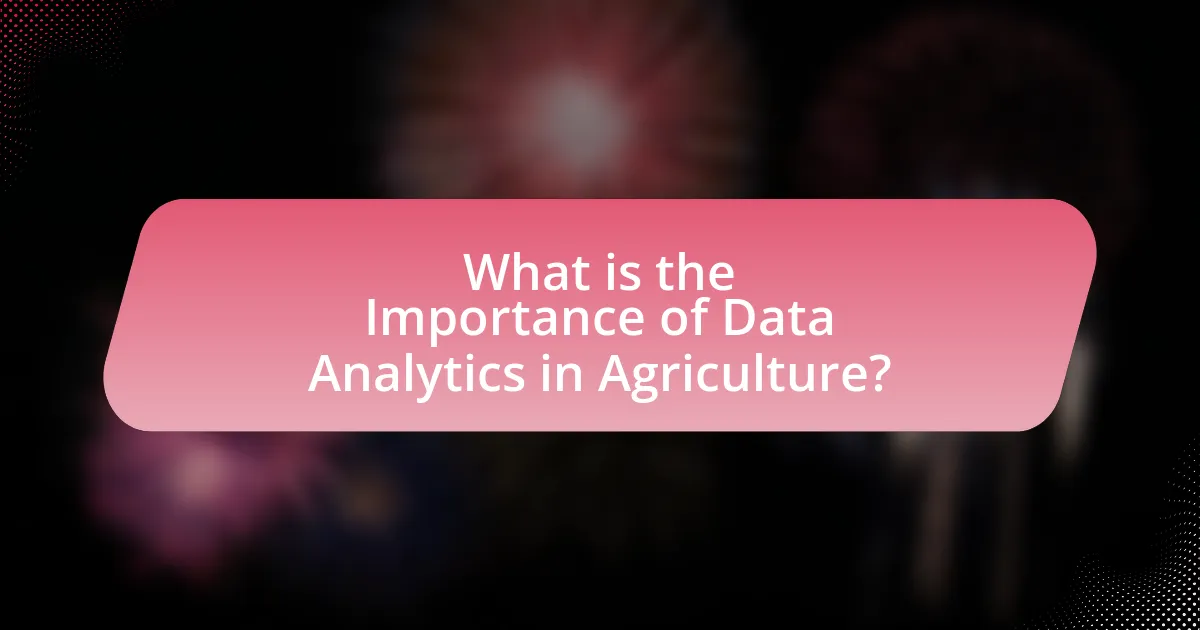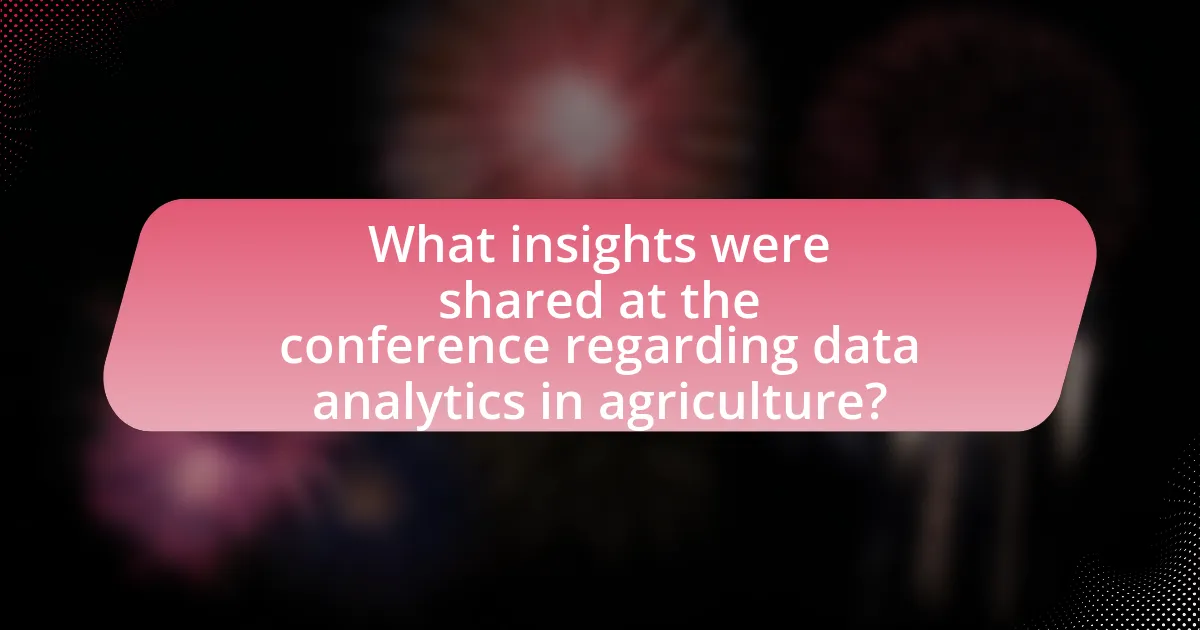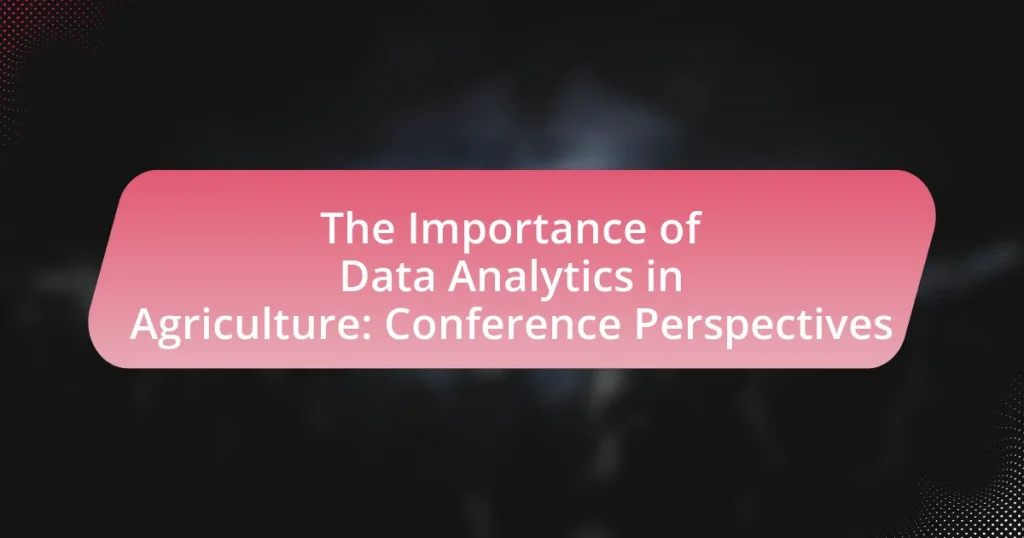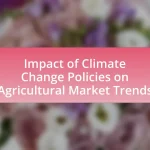The article “The Importance of Data Analytics in Agriculture: Conference Perspectives” emphasizes the critical role of data analytics in enhancing agricultural practices. It outlines how data-driven decision-making improves productivity, optimizes resource use, and increases crop yields, with studies indicating potential yield increases of up to 20%. Key technologies such as machine learning, IoT, and big data analytics are discussed for their transformative impact on farming efficiency and sustainability. The article also highlights the challenges faced by farmers without data analytics and the importance of collaboration among stakeholders to advance agricultural technology. Additionally, it explores future prospects and best practices for integrating advanced analytics into farming operations.

What is the Importance of Data Analytics in Agriculture?
Data analytics is crucial in agriculture as it enhances decision-making, optimizes resource use, and increases crop yields. By analyzing data from various sources such as weather patterns, soil conditions, and crop performance, farmers can make informed choices that lead to improved productivity. For instance, a study by the Food and Agriculture Organization (FAO) highlights that precision agriculture, which relies heavily on data analytics, can increase crop yields by up to 20% while reducing input costs by 10-15%. This demonstrates the significant impact of data analytics on agricultural efficiency and sustainability.
How does data analytics transform agricultural practices?
Data analytics transforms agricultural practices by enabling farmers to make data-driven decisions that enhance productivity and sustainability. By analyzing data from various sources such as weather patterns, soil conditions, and crop health, farmers can optimize resource allocation, improve yield predictions, and reduce waste. For instance, precision agriculture techniques, which utilize data analytics, have been shown to increase crop yields by up to 20% while minimizing input costs. Additionally, data analytics facilitates real-time monitoring of crops, allowing for timely interventions that can prevent losses due to pests or diseases. This shift towards data-centric approaches in agriculture not only boosts efficiency but also supports sustainable farming practices by promoting responsible resource management.
What are the key technologies used in agricultural data analytics?
Key technologies used in agricultural data analytics include machine learning, remote sensing, Internet of Things (IoT), and big data analytics. Machine learning algorithms analyze large datasets to identify patterns and make predictions about crop yields and pest infestations. Remote sensing technologies, such as satellite imagery and drones, provide real-time data on crop health and soil conditions. IoT devices, including sensors and smart equipment, collect data from the field, enabling precise monitoring and management of agricultural practices. Big data analytics processes vast amounts of information from various sources, allowing farmers to make data-driven decisions that enhance productivity and sustainability. These technologies collectively improve efficiency and effectiveness in agricultural operations.
How do these technologies enhance decision-making in agriculture?
Technologies such as data analytics, precision agriculture, and IoT enhance decision-making in agriculture by providing real-time insights and actionable data. These technologies enable farmers to analyze soil conditions, weather patterns, and crop health, leading to informed decisions that optimize resource use and increase yields. For instance, a study by the Food and Agriculture Organization (FAO) highlights that precision agriculture can increase crop productivity by up to 20% through targeted interventions based on data analysis. This data-driven approach allows for better risk management and improved sustainability in agricultural practices.
Why is data-driven decision-making crucial for farmers?
Data-driven decision-making is crucial for farmers because it enhances productivity and efficiency in agricultural practices. By utilizing data analytics, farmers can make informed choices regarding crop selection, resource allocation, and pest management, leading to optimized yields. For instance, a study by the Food and Agriculture Organization (FAO) indicates that precision agriculture, which relies on data analysis, can increase crop yields by up to 20% while reducing input costs by 10-15%. This evidence underscores the importance of data in driving sustainable farming practices and improving overall farm profitability.
What challenges do farmers face without data analytics?
Farmers face significant challenges without data analytics, including inefficient resource management, reduced crop yields, and increased vulnerability to market fluctuations. Without data-driven insights, farmers struggle to optimize water usage, fertilizer application, and pest control, leading to wasted resources and lower productivity. For instance, a study by the Food and Agriculture Organization indicates that precision agriculture, which relies on data analytics, can increase crop yields by up to 20%. Additionally, without access to market data, farmers may make uninformed decisions, resulting in financial losses and an inability to adapt to changing market demands.
How can data analytics improve crop yield and sustainability?
Data analytics can significantly improve crop yield and sustainability by enabling farmers to make data-driven decisions based on real-time insights. By analyzing data from various sources such as soil sensors, weather forecasts, and crop health imagery, farmers can optimize resource allocation, enhance pest management, and improve irrigation practices. For instance, a study published in the journal “Precision Agriculture” found that farms utilizing data analytics experienced an average yield increase of 15% while reducing water usage by 20%. This demonstrates that data analytics not only boosts productivity but also promotes sustainable farming practices by minimizing environmental impact.

What insights were shared at the conference regarding data analytics in agriculture?
The conference highlighted that data analytics significantly enhances decision-making in agriculture by providing actionable insights. Experts discussed how predictive analytics can optimize crop yields and resource management, citing a study that showed a 20% increase in efficiency when farmers utilized data-driven strategies. Additionally, the integration of IoT devices for real-time data collection was emphasized, demonstrating its role in precision farming and sustainability efforts.
What were the main themes discussed by experts at the conference?
The main themes discussed by experts at the conference included the integration of data analytics in precision agriculture, the role of big data in enhancing crop yields, and the impact of predictive analytics on resource management. Experts highlighted that precision agriculture utilizes data analytics to optimize farming practices, leading to increased efficiency and sustainability. Additionally, they emphasized that big data analytics can significantly improve decision-making processes, resulting in higher crop yields and better resource allocation. The discussions also covered how predictive analytics can forecast weather patterns and pest outbreaks, enabling farmers to make informed decisions that enhance productivity and reduce waste.
How do these themes reflect current trends in agricultural technology?
The themes discussed in “The Importance of Data Analytics in Agriculture: Conference Perspectives” reflect current trends in agricultural technology by emphasizing the integration of data analytics for improved decision-making and efficiency. Data analytics enables farmers to optimize resource allocation, enhance crop yields, and reduce waste through precise monitoring and predictive modeling. For instance, the use of satellite imagery and IoT sensors allows for real-time data collection, which supports precision agriculture practices. According to a report by MarketsandMarkets, the global precision farming market is projected to grow from $7 billion in 2020 to $12 billion by 2025, highlighting the increasing reliance on data-driven technologies in agriculture. This trend underscores the shift towards more sustainable and productive farming practices, driven by advancements in data analytics.
What case studies were presented to illustrate successful data analytics applications?
The case studies presented to illustrate successful data analytics applications in agriculture include the use of predictive analytics for crop yield forecasting and precision agriculture techniques that optimize resource usage. For instance, a case study highlighted how a farming operation utilized machine learning algorithms to analyze historical weather data and soil conditions, resulting in a 20% increase in crop yields. Another example involved a company implementing IoT sensors to monitor soil moisture levels, which led to a 30% reduction in water usage while maintaining crop health. These examples demonstrate the tangible benefits of data analytics in enhancing agricultural productivity and sustainability.
What role do stakeholders play in advancing data analytics in agriculture?
Stakeholders play a crucial role in advancing data analytics in agriculture by facilitating collaboration, funding, and the sharing of knowledge and resources. Agricultural stakeholders, including farmers, agribusinesses, researchers, and policymakers, contribute to the development and implementation of data analytics technologies that enhance productivity and sustainability. For instance, partnerships between universities and agricultural companies have led to innovative data-driven solutions, such as precision farming techniques that optimize resource use and increase crop yields. Additionally, stakeholders often provide financial support for research initiatives, enabling the exploration of new data analytics methodologies that can address specific agricultural challenges. This collaborative approach ensures that data analytics is effectively integrated into agricultural practices, ultimately leading to improved decision-making and enhanced agricultural outcomes.
How can collaboration between farmers and tech companies enhance data utilization?
Collaboration between farmers and tech companies can enhance data utilization by integrating advanced technologies such as IoT, AI, and big data analytics into agricultural practices. This partnership allows farmers to collect real-time data on soil health, crop conditions, and weather patterns, which can be analyzed to make informed decisions that improve yield and resource efficiency. For instance, a study by the Food and Agriculture Organization (FAO) highlights that precision agriculture, driven by data analytics, can increase crop productivity by up to 20% while reducing input costs. By leveraging the expertise of tech companies, farmers can access sophisticated tools and platforms that transform raw data into actionable insights, ultimately leading to more sustainable farming practices and increased profitability.
What policies are needed to support data analytics in the agricultural sector?
Policies needed to support data analytics in the agricultural sector include investment in digital infrastructure, data privacy regulations, and training programs for farmers. Investment in digital infrastructure ensures reliable internet access and data storage solutions, which are critical for effective data collection and analysis. Data privacy regulations protect sensitive information while encouraging data sharing among stakeholders, fostering collaboration and innovation. Training programs equip farmers with the necessary skills to utilize data analytics tools, enhancing their decision-making capabilities. These policies collectively create an environment conducive to the adoption and effective use of data analytics in agriculture, ultimately improving productivity and sustainability.

What are the future prospects of data analytics in agriculture?
The future prospects of data analytics in agriculture are highly promising, as advancements in technology continue to enhance precision farming, resource management, and yield optimization. The integration of big data, machine learning, and IoT devices allows farmers to make data-driven decisions that improve crop productivity and sustainability. For instance, a report by the Food and Agriculture Organization (FAO) indicates that data analytics can increase agricultural productivity by up to 30% through optimized resource allocation and pest management strategies. Furthermore, the global market for agricultural analytics is projected to reach $2.5 billion by 2025, reflecting the growing recognition of data’s role in enhancing agricultural efficiency and profitability.
How is the landscape of agricultural data analytics expected to evolve?
The landscape of agricultural data analytics is expected to evolve through increased integration of artificial intelligence and machine learning technologies, enhancing predictive analytics and decision-making processes. As farmers adopt precision agriculture techniques, data analytics will enable real-time monitoring of crop health, soil conditions, and weather patterns, leading to optimized resource allocation and improved yields. According to a report by MarketsandMarkets, the agricultural analytics market is projected to grow from $1.2 billion in 2020 to $4.8 billion by 2025, indicating a significant shift towards data-driven farming practices. This evolution will also involve greater collaboration between agritech companies and farmers, fostering innovation and the development of tailored analytics solutions.
What emerging technologies could shape the future of agriculture?
Emerging technologies that could shape the future of agriculture include precision agriculture, artificial intelligence (AI), and biotechnology. Precision agriculture utilizes data analytics to optimize field-level management regarding crop farming. AI enhances decision-making processes by analyzing vast amounts of agricultural data, leading to improved yield predictions and resource management. Biotechnology, including genetic engineering and CRISPR technology, enables the development of crops that are more resilient to pests and climate change. According to a report by the Food and Agriculture Organization, the integration of these technologies can increase agricultural productivity by up to 70% by 2050, addressing the growing global food demand.
How can farmers prepare for the integration of advanced analytics?
Farmers can prepare for the integration of advanced analytics by investing in data collection technologies and training their workforce. Implementing precision agriculture tools, such as sensors and drones, allows farmers to gather real-time data on soil health, crop conditions, and weather patterns. Training programs focused on data interpretation and analytics will enable farmers to make informed decisions based on the insights derived from this data. According to a report by McKinsey & Company, farms that adopt data-driven practices can increase their productivity by 10-20%, demonstrating the tangible benefits of advanced analytics in agriculture.
What best practices should be adopted for effective data analytics in agriculture?
Effective data analytics in agriculture requires adopting best practices such as integrating precision agriculture technologies, utilizing real-time data collection, and ensuring data quality and accessibility. Precision agriculture technologies, including GPS and IoT sensors, enable farmers to gather detailed information about soil conditions, crop health, and weather patterns, leading to more informed decision-making. Real-time data collection allows for timely interventions, optimizing resource use and improving yields. Ensuring data quality involves regular validation and cleaning processes, which are essential for accurate analysis and reliable insights. According to a report by McKinsey & Company, implementing these practices can increase agricultural productivity by up to 20%.
How can farmers ensure data quality and accuracy?
Farmers can ensure data quality and accuracy by implementing standardized data collection methods and utilizing reliable technology. Standardized methods, such as using calibrated sensors and consistent data entry protocols, minimize errors and enhance data reliability. Additionally, employing advanced technologies like precision agriculture tools, which include GPS and IoT devices, allows for real-time data monitoring and validation. Research indicates that farms utilizing precision agriculture report up to a 15% increase in yield due to improved data accuracy, demonstrating the effectiveness of these practices in enhancing agricultural productivity.
What strategies can be implemented to maximize the benefits of data analytics?
To maximize the benefits of data analytics in agriculture, implementing strategies such as integrating real-time data collection, utilizing predictive analytics, and fostering cross-disciplinary collaboration is essential. Real-time data collection enables farmers to monitor crop health and environmental conditions instantly, leading to timely decision-making. Predictive analytics can forecast yields and identify potential issues before they arise, enhancing resource allocation and risk management. Cross-disciplinary collaboration among agronomists, data scientists, and technology experts ensures that insights from data analytics are effectively translated into actionable agricultural practices. These strategies are supported by studies indicating that data-driven decision-making can increase crop yields by up to 20% and reduce costs by 15%, demonstrating the tangible benefits of effective data analytics in agriculture.















